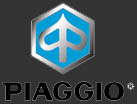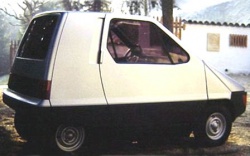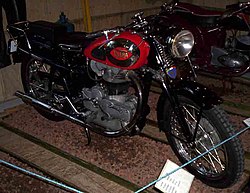Difference between revisions of "Piaggio"
m |
m |
||
| (6 intermediate revisions by the same user not shown) | |||
| Line 1: | Line 1: | ||
| − | + | {{X}} | |
| − | [[Image:Piaggiobrandlogo.jpg| | + | [[Image:Piaggiobrandlogo.jpg|150px|center|]] |
| − | + | [[Image:014.jpg|thumb|300px|'''Vespa Scooter at [http://www.woiow.com Wheels Of Italy]]]''' | |
| − | + | [[File:1974 Vettura Piaggio 50cc.jpg|thumb|right|250px|'''1974 Piaggio Vettura 50cc ''']] | |
| − | [[Image:014.jpg|thumb|300px|'''Vespa Scooter at Wheels Of Italy''']] | ||
'''Piaggio''' is a company based in [[Italy]] that produces cars, motorcycles, scooters and aeroplanes. | '''Piaggio''' is a company based in [[Italy]] that produces cars, motorcycles, scooters and aeroplanes. | ||
| Line 15: | Line 14: | ||
Aeronautical engineer Corradino D'Ascanio, responsible for the design and construction of the first modern helicopter by [[Agusta]], was given the job of designing a simple, robust and affordable vehicle by Enrico Piaggio. The vehicle had to be easy to drive for both men and women, be able to carry a passenger, and not get its driver's clothes dirty. Consequently, in 1946 Piaggio launched the [[Vespa]] (Italian for "wasp") scooter, and within 10 years over a million units had been produced. | Aeronautical engineer Corradino D'Ascanio, responsible for the design and construction of the first modern helicopter by [[Agusta]], was given the job of designing a simple, robust and affordable vehicle by Enrico Piaggio. The vehicle had to be easy to drive for both men and women, be able to carry a passenger, and not get its driver's clothes dirty. Consequently, in 1946 Piaggio launched the [[Vespa]] (Italian for "wasp") scooter, and within 10 years over a million units had been produced. | ||
| + | |||
==Development== | ==Development== | ||
| Line 22: | Line 22: | ||
In [[1969]] the motorcycle company purchased [[Gilera]].[[Image:Gilera.jpg|thumb|250px]] | In [[1969]] the motorcycle company purchased [[Gilera]].[[Image:Gilera.jpg|thumb|250px]] | ||
| + | |||
==Under New Ownership== | ==Under New Ownership== | ||
| Line 35: | Line 36: | ||
One of Piaggio's problems Mr. Colaninno couldn't fix from the inside was its scale. Even though Piaggio was the European market leader, it was dwarfed by rivals [[Honda]] and [[Yamaha Motor Company|Yamaha]]. A year after rescuing Piaggio, Colaninno decided to salvage another Italian brand: scooter and motorcycle maker [[Aprilia]]. | One of Piaggio's problems Mr. Colaninno couldn't fix from the inside was its scale. Even though Piaggio was the European market leader, it was dwarfed by rivals [[Honda]] and [[Yamaha Motor Company|Yamaha]]. A year after rescuing Piaggio, Colaninno decided to salvage another Italian brand: scooter and motorcycle maker [[Aprilia]]. | ||
| + | |||
| + | |||
| + | In [[1957]] they produced the [[Vespa (car)|Vespa]] 400, a tiny passenger car. The company's [[Piaggio Aero]] division builds aircraft. | ||
| + | |||
| + | |||
==Brands and models== | ==Brands and models== | ||
| Line 68: | Line 74: | ||
* [http://www.vespaforever.net Vespa Scooter] | * [http://www.vespaforever.net Vespa Scooter] | ||
*[http://www.vesparesources.com Vespa Resources - forum and articles] in Italian, English and German | *[http://www.vesparesources.com Vespa Resources - forum and articles] in Italian, English and German | ||
| + | |||
| + | |||
| + | {{-}} | ||
| + | {{A-Z multipage list|Motorcycle Information and Photos by Marque|Motorcycle Information and Photos by Marque|}} | ||
| + | {{A-Z multipage list|Car Information and Photos by Marque|Information and Photos by Marque|}} | ||
| + | {{Motorcycle Information and Photos by Marque}} | ||
| + | {{Car Information and Photos by Marque}} | ||
| + | |||
[[Category:Piaggio Group| ]] | [[Category:Piaggio Group| ]] | ||
| Line 75: | Line 89: | ||
[[Category:Scooter manufacturers]] | [[Category:Scooter manufacturers]] | ||
[[Category:Moped manufacturers]] | [[Category:Moped manufacturers]] | ||
| − | |||
| − | |||
| − | |||
| − | |||
| − | |||
| − | |||
| − | |||
| − | |||
| − | |||
| − | |||
| − | |||
| − | |||
| − | |||
Latest revision as of 13:29, 30 April 2010

Piaggio is a company based in Italy that produces cars, motorcycles, scooters and aeroplanes.
History
Founded by Rinaldo Piaggio in 1884, Piaggio initially produced locomotives and railway carriages. During World War I the company focused on producing airplanes.
During World War II the company produced fighter planes, but Piaggio emerged from the conflict with its Pontedera plant completely demolished by bombing. Italy's crippled economy and the disastrous state of the roads did not assist in the re-development of the automobile markets. Enrico Piaggio, the son of Piaggio's founder Rinaldo Piaggio, decided to leave the aeronautical field in order to address Italy's urgent need for a modern and affordable mode of transportation. The idea was to design a cheap vehicle for the masses.
- For the full story, see separate article on Vespa
Aeronautical engineer Corradino D'Ascanio, responsible for the design and construction of the first modern helicopter by Agusta, was given the job of designing a simple, robust and affordable vehicle by Enrico Piaggio. The vehicle had to be easy to drive for both men and women, be able to carry a passenger, and not get its driver's clothes dirty. Consequently, in 1946 Piaggio launched the Vespa (Italian for "wasp") scooter, and within 10 years over a million units had been produced.
Development
Piaggio had a strong cash flow emanating from the success of the Vespa, and decided to develop other products. In 1957 they produced the Vespa 400, a tiny passenger car.
In 1959, Piaggio came under the control of the Agnelli family, the owners of car maker Fiat SpA. Resultantly, as the wider ownership of Fiat in Italian industry, in the 1964 the two divisions (aeronautical and motorcycle) split to become two independent companies; the aeronautical division was named IAM Rinaldo Piaggio. Today the airplane-company Piaggio Aero is controlled by the family of Piero Ferrari, who also still holds 10% of the famous car maker Ferrari.
In 1969 the motorcycle company purchased Gilera.
Under New Ownership
In 2003, the company found itself close to bankcruptcy. Continual management changes had led millions spent on many different plans and products had saddled Piaggio with crushing debts and left it vulnerable to competition from cheaper Asian rivals.
In 1959, Piaggio came under the control of the Agnelli family, the owners of car maker Fiat SpA. Vespa thrived, until 1992 when Giovanni Alberto Agnelli became CEO - but Agnelli was already suffering from cancer, and died in 1997. In 1999, Morgan Grenfell Private Equity acquired Piaggio, but a quickly hoped for sale was dashed by a failed joint venture in China. In Italy, Piaggio invested 15 million euros ($19.4 million) in a new motorcycle but dropped it after building a prototype. By the end of 2002, the company had run up 577 million euros in debt on revenues of 945 million euros, and booked a loss of 129 million euros.
Then came Roberto Colaninno: A lot of people told me I was crazy. Piaggio wasn't dying. It just needed to be treated better. Piaggio's financial was in a bad shape, but its brand was still well known and its product were featuring in more Hollywood films thanks to the Vespa ET4. In 1995, Colaninno had pulled off what was then Europe's largest-ever hostile takeover when he took control of Telecom Italia SpA. In October 2003, Mr. Colaninno made an initial investment of 100 million euros through his holding company Immsi SpA in exchange for just under a third of Piaggio and the mandate to run it. Chief executive Rocco Sabelli, redesigned the factory to Japanese principles, and redesigned the factory so that every Piaggio scooter could be made on any assembly line.
Unlike the turnaround recipe applied at U.S. auto makers, Mr. Colaninno didn't fire a single worker - a move which helped seduce the company's skeptical unions. "Everyone in a company is part of the value chain," said Colaninno. All bonuses for blue-collar workers and management were based on the same criteria: profit margins and customer satisfaction; and air conditioning was installed in the factory. He also gave the company's engineers, who had been idled by the company's financial crisis, deadlines for projects - they rolled out two world firsts in 2004: a gas-electric hybrid scooter; a scooter with two wheels in front and one in back which grips the road better.
One of Piaggio's problems Mr. Colaninno couldn't fix from the inside was its scale. Even though Piaggio was the European market leader, it was dwarfed by rivals Honda and Yamaha. A year after rescuing Piaggio, Colaninno decided to salvage another Italian brand: scooter and motorcycle maker Aprilia.
In 1957 they produced the Vespa 400, a tiny passenger car. The company's Piaggio Aero division builds aircraft.
Brands and models
Group brands
- Aprilia - motorcycles and scooters
- Derbi - motorcycles, scooters, and recreational ATVs (quads)
- Gilera - motorcycles
- Ligier - 4wheel micro automobiles
- Moto Guzzi - motorcycles
- Piaggio - scooters
- Vespa - scooters
Piaggio Models
- Piaggio Ape 3-wheel submicro pickups.
- Piaggio Porter 4-wheel micro-vans and micro-pickups, same as a Daihatsu Hijet.
- Piaggio Avanti 180
- Piaggio MP3 3-wheel scooter.
- Piaggio BV500 - neo-classic style, automatic transmission, top-speed 100mph
- X9 - sport-bike style, automatic transmission, top-speed 100mph
- BV200 / BV250
- FLY150
- Typhoon (50cc)
- Sfera NSL (50cc & 80cc) 1991-1995
- Sfera RST (RST standing for Restyle) (50cc 2-Stroke & 125cc 4-Stroke) 1995 - ??
- NRG mc1-3 (50 cc) (mc standing for mark.)
- Zip (50cc 2-Stroke & 125cc 4-Stroke)
External links
- Official website
- Piaggio nrg power
- Vespa Scooter
- Vespa Resources - forum and articles in Italian, English and German
| Motorcycle Information and Photos by Marque: A - B - C - D - E - F - G - H - I - J - K - L - M - N - O - P - Q - R - S - T - U - V - W - X - Y - Z |
| Car Information and Photos by Marque: A - B - C - D - E - F - G - H - I - J - K - L - M - N - O - P - Q - R - S - T - U - V - W - X - Y - Z |


